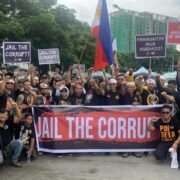Corruption in retrospect

There is an old Spanish saying, that in stealing, “one must steal threefold: once for himself, once for his judge, and once to pay the penalty.” This may explain the outrageous sums stolen in flood control projects over the years. When it rains, it really pours, and what makes us retch is not the amount of money stolen, but the impunity that has made all this possible. Can we expect the House of Representatives and the Senate to truly investigate their own members? Isn’t it unfair that the current secretary of Public Works and Highways is grilled by a committee that includes his predecessor? Shouldn’t both be in the hot seat together? All these investigations “in aid of legislation” reminded me of the “residencia” and the “visita” that were judicial reviews of an official’s conduct during the Spanish colonial period.
Residencia was a judicial review conducted at the end of a term of office. Visita was an unscheduled, oftentimes secret, investigation of an official during his term of office. Residencia, literally “residence,” referred to an appointed judge physically “residing” in the area of investigation to conduct a public hearing and compile all complaints against an outgoing official. Visita, literally “visit,” or in Philippine usage “visitor,” referred to a “visitador” or special investigator sent from Spain to look into the conduct of officials. In principle, residencia was a way to instill morale in the bureaucracy, but in actual practice, it became a way for the spiteful to make life miserable for the official being investigated. The standard work on today’s topic is Charles Henry Cunningham’s “The Spanish Audiencia in the Spanish Colonies as illustrated by the Audiencia of Manila” (1919) and a more detailed article, “The Residencia in the Spanish Colonies” (1918).
A residencia for a governor general took at least six months and was conducted by the outgoing governor’s successor. However, the arrival of a new governor, owing to the long voyage and slow communication between Manila, Mexico, and Madrid, led to residencias being undertaken by the Audiencia or other officials. During the residencia, complaints were collected, charges were investigated, and a recommendation was sent to the Council of the Indies for final judgment. Residencia was kept to the end of a governor’s term because entertaining any and all complaints during his term would paralyze him into inaction. The deterrent to wrongdoing was the knowledge that at the end of his term, there would be a day of reckoning.
Governors were not allowed to leave Manila for retirement or to assume another post until the residencia was completed, and by 1776, an annual deduction in their salary was taken as a deposit to cover the costs and liabilities of their residencia. For lower-ranking officials, like alcaldes mayores and corregidores, their last year’s salary was withheld pending residencia. If cleared, deposits were returned. If found guilty, the deposit, back salary, and other fines were collected. Worse, some governors were not only removed from office but were also imprisoned or exiled during the residencia.
Cunningham spared me the trouble of going through the archive to look up residencias of governors general in Manila. Cunningham himself noted that there was not enough space to cover all residencias in his article, so he chose a few from the most important ones to illustrate how the system worked. His first example was the sad case of late governor Diego de Salcedo in 1670. Removed by the commissioner of the Inquisition in 1668, his residencia was to be done by the senior magistrate of the Audiencia of Manila, who was the possible successor to the governor. The conflict of interest was settled by an order from Spain that arrived in Manila in 1671. By then, Salcedo had already been dead for three years! Residencia went on for another two years to its conclusion. Death did not spare governors Francisco de Tello de Guzman (+1603) and Pedro Bravo de Acuña (+1606) from residencia. They were not physically present at trial to answer for their unexplained wealth; after the residencia, their property was confiscated.
In another case, Gonzalo Ronquillo de Peñalosa undertook the residencia of his predecessor, Francisco de Sande and levied a heavy fine. Sande appealed the case to the Audiencia of Mexico, where he had been appointed as oidor following his term as governor in Manila! In 1582, Ronquillo wrote the king regarding the checkmate in the residencia. From all the examples, it is clear that the residencia was good in principle but bad when implemented.
Cunningham, in a footnote, made this remark so relevant to the corruption scandals today: “There were many opportunities for profit, commercial, and otherwise, legitimate and illegitimate … It is probable that most of the governors were dishonest, as the opportunities for corruption were numerous. The temptations offered by the position were too strong for the powers of resistance of any human being … entrusted with the assignment of all sorts of lucrative offices … with friends, relatives, and special interests to serve, a governor was surrounded by countless officials who were eagerly awaiting their share of the booty.”
Is this history repeating itself, or are Filipinos today repeating history?
Ambeth is a Public Historian whose research covers 19th century Philippines: its art, culture, and the people who figure in the birth of the nation. Professor and former Chair, Department of History, Ateneo de Manila University, he writes a widely-read editorial page column for the Philippine Daily Inquirer, and has published over 30 books—the most recent being: Martial Law: Looking Back 15 (Anvil, 2021) and Yaman: History and Heritage in Philippine Money (Bangko Sentral ng Pilipinas, 2021).


















Agenda for prosperity and accountability